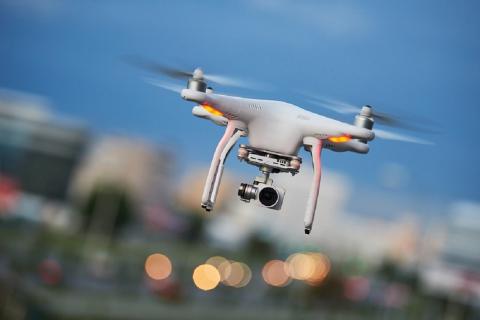www.CapTechU.edu
With the development of unmanned systems technology comes tremendous potential, especially in the field of aviation. According to an economic report by the Association for Unmanned Vehicle Systems International, the largest growth of UAS will be in commercial applications. The FAA considers unmanned aircraft (commonly known as “drones”) to be aircraft and thus subject to regulation for safety reasons.

Some of these myths may be more widespread than others. The numbering below does not necessarily indicate relative importance or prevalence.
Myth 1: It’s not a drone. It’s an unmanned aircraft.
A few years ago, the word “drone” was commonly used by the media and public to refer to military UAS being utilized overseas. Such connotations became disconcerting when applied to three-pound quadcopters flown by civilians in their back yards. Over time, however, many have come to understand that “drone” means any unmanned aircraft (UA), regardless of use, and the term has now become well-established. Other terms used by the industry include unmanned aerial vehicles (UAV), unmanned aircraft systems (UAS), and remotely-piloted aircraft (RPA).
In addition, “drone” is used for vehicles in other environments such as underwater or on land. Underwater drones are also referred to as remotely operated vehicles or ROVs, while ground drones are unmanned ground vehicles or UGVs.
Myth 2: There are no laws that regulate drones.
The next time you hear someone say (or post on social media) that drones are unregulated, you may want to suggest they check their facts. The Federal Aviation Administration (FAA) is responsible for the safety of people and aircraft in the National Airspace System and has broad authority over any aircraft (including drones) flying in it. Under Title 49 U.S.C. § 44701, all civil aircraft are subject to FAA regulation. Definitions found under Title 49 U.S.C. § 40102(a)(6) and Title 14 C.F.R. § 1.1 state that unmanned aircraft are aircraft, regardless of whether the operation is for recreational, hobby, business, or commercial purposes. Under these statutes, the FAA considers hobby and model aircraft to be “aircraft” and to be regulated as such. The FAA Modernization and Reform Act of 2012 (Public Law 112-95) Section 336 set specific requirements for hobbyists and model operators for safe operations.
Myth 3: A model aircraft is not a drone or unmanned aircraft
Under Section 336 of Public Law 112-95, Congress legally defined a model aircraft as a type of unmanned aircraft. Section 331(6),(8), and (9) define the terms “small unmanned aircraft,” “unmanned aircraft,” and “unmanned aircraft system” as aircraft. Model aircraft are also defined as “aircraft” per Public Law 112-95, section 336(c). Therefore, a model aircraft is an unmanned aircraft or a “drone.”
The difference between a model aircraft and a UAS is that a model aircraft is flown within visual line of sight of the person operating the aircraft and flown for hobby or recreational purposes only. If a person is operating a “model aircraft” for a commercial purpose, then it is legally a UAS and the operator must have the proper FAA authorization.
Myth 4: Drones will invade our privacy.
The unmanned systems industry (air, ground and water) is not opposed to privacy laws. However, there is opposition to legislation that focuses on one type of technology while overlooking problems and risks such as the handling of data. Privacy legislation should concentrate on the data collected regardless of method, and consider the protections provided by the First Amendment. Legislators should consider privacy with a “technology-neutral” approach because of rapid technology change. Also, current FAA safety regulations already prevent many privacy problems with drones because of limitations on proximity to structures and overflight of people.
Myth 5: Drones are armed and dangerous.
Many people still consider drones to be ominous flying objects, controlled remotely, and ready to attack at any time. Such perceptions often stem from media coverage that highlight military UAVs firing missiles. In reality, the majority of U.S. military unmanned aircraft are unarmed. They are used not to deploy weapons but to acquire imagery that often helps save the lives of troops on the ground.
The FAA’s position is that, under federal law, armed non-military aircraft (manned or unmanned) are strictly prohibited and illegal. Under Title 14 CFR Part 107.36, the carrying of hazardous materials is also forbidden. Title 49 CFR 171.8 states that items such as explosives, compressed gas, and flammable gas are prohibited. Therefore, weapons of any kind, flamethrowers, and paintball or airsoft guns cannot be attached to a UAS.
Myth 6: Drones are easy to operate.
Chances are, you’ve seen pictures or video of someone flying a drone with a hand-held controller, or even with first-person-view goggles. You may have seen drone racing. In all these cases, operating a drone can look easier than it actually is. There are numerous safety and risk management issues that should be addressed.
Every UAS operator should have training and knowledge of the system. Even though some UAS have automated safety features, piloting skills are still needed to manage unexpected problems. No one is exempt from the occasional system failure or communication interruption. Some vehicles may require extensive practice to learn their particular handling features or non-intuitive interfaces.
Learning to operate a drone correctly and effectively makes for an excellent investment. Many UAS manufacturers offer training or can advise where to obtain it. Some courses take a few days and others may take weeks. Regardless, this may be an opportunity to obtain your Part 107 remote pilot operator certificate.
Myth 7: Drones are only used for spying and military operations.
Over the past 100 years, much of our aviation technology has been developed by the military and eventually found its way to civilian applications. Over time, civil non-military applications have grown larger and more numerous than military ones. The same will be true with unmanned aircraft (“drones”). Considerable attention has been given to the use of drones by law enforcement and government agencies, but there are many other potential non-military uses.
Unmanned systems are tools that extend human capabilities and improve efficiency, and unmanned aircraft can aid commerce and industry in countless ways. As stated by AUVSI’s economic report and report on the first 1000 commercial UAS exemptions, drones are being used – or will be used in the near future -- for precision agriculture, surveying, news reporting, videography, cargo delivery, first responder support, firefighting, and utilities. They can be used on building sites, to aid in train maintenance, or as part of aircraft manufacturing. Indeed, the number of applications for unmanned aircraft is limited only by current technology and the imaginations of UAS operators in finding new ways to apply them. Since the release of the FAA’s Part 107 for small unmanned aircraft, the commercial world is seeing a profound impact.

While it is true that UAVs weighing less than 250g are in high demand, particularly among hobbyists, drones in general have many purposes besides recreation (see Myth 7, above). It is estimated that the market was worth $17 billion in 2017; this figure is expected to reach $30 billion by 2022. It is also estimated that 250,000 will be employed in the sector globally within five years.
Myth 9: Drones could cause an aircraft to crash.
Exclusion zones exist around airfields in order to prevent interference with planes as they take off and land. If a large drone hit the engine intake at the critical stage of takeoff, the effect could be serious.
That said, aircraft (B-777 for example) have powerful engines that are designed to accommodate an engine loss at critical flight stages. A skilled pilot would be expected to control the aircraft and land safely.
By Richard E. Baker, PhD
No comments:
Post a Comment